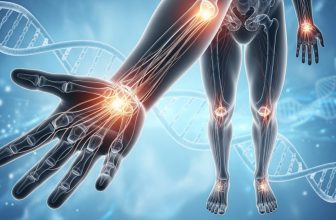
5 Hidden Dangers of Diabetes That Can Worsen Dupuytren’s Disease
Introduction
Diabetes doesn’t just affect blood sugar—it quietly reshapes the body’s connective tissue. Beyond fatigue, nerve damage, or circulation problems, one of the lesser-known complications is Dupuytren’s contracture—a hand condition that thickens and tightens the fascia beneath the skin, bending the fingers toward the palm.
Research consistently shows that diabetes is one of the strongest metabolic risk factors for Dupuytren’s, increasing both the likelihood of developing it and the chances of recurrence after treatment. Understanding this connection helps patients take control of their metabolic and musculoskeletal health before the condition worsens.
1. Glycation: When Sugar Hardens the Body’s Tissues
Chronically high blood glucose levels lead to a process called glycation, where sugar molecules bind to proteins like collagen and elastin. Over time, this “sugar-coating” stiffens these vital structural proteins, making tissues less flexible and more prone to damage.
In the palm, this process accelerates fibroblast overactivity—the exact mechanism that causes the cords and nodules of Dupuytren’s disease. Glycation doesn’t just affect the hands—it impacts joints, tendons, and blood vessels throughout the body.
2. Insulin Resistance: The Hidden Fibrosis Trigger
When the body becomes resistant to insulin, it must produce more to keep blood sugar under control. This excess insulin acts like a growth signal, stimulating fibroblasts (the collagen-producing cells) to multiply.
This overactivation leads to faster collagen buildup and fibrosis, especially in tissues already prone to thickening. Over time, it’s like pouring fuel on the fire—Dupuytren’s progresses faster and becomes more resistant to standard treatments like surgery or enzyme injections.
3. Poor Circulation Slows Healing and Recovery
Diabetes is notorious for damaging small blood vessels, a process known as microangiopathy. In Dupuytren’s patients, this means reduced oxygen and nutrient delivery to healing tissue after any treatment—whether surgery or collagenase injection.
This impaired circulation results in:
-
Slower wound healing
-
Greater stiffness and scarring
-
Increased risk of recurrence
Patients with well-managed blood sugar and circulation typically heal faster and regain better finger mobility after treatment.
4. Chronic Inflammation: The Silent Worsener
High blood sugar and insulin resistance both create systemic inflammation. Over time, inflammatory cytokines signal fibroblasts to produce more collagen and extracellular matrix, thickening the palmar fascia even more.
Studies in Diabetologia and The Journal of Hand Surgery confirm that Dupuytren’s is two to three times more common in people with type 2 diabetes, particularly those with poor glucose control or long-standing disease.
The longer diabetes persists unchecked, the more aggressively Dupuytren’s tends to develop.
5. Missed Warning Signs: When Dupuytren’s Signals a Bigger Problem
In some patients, Dupuytren’s contracture may be an early sign of metabolic dysfunction—even before a formal diabetes diagnosis. Because insulin resistance affects connective tissues early, subtle hand stiffness or small nodules might appear before blood sugar spikes reach diabetic levels.
If you notice thickened cords, reduced grip flexibility, or finger stiffness, it’s wise to check fasting glucose and A1C levels. Catching metabolic imbalance early can help slow Dupuytren’s progression naturally.
What Patients Can Do
Managing both conditions together requires a metabolic and mechanical approach:
-
Monitor glucose levels regularly and maintain target A1C.
-
Cut back on refined sugars and carbohydrates to reduce glycation and inflammation.
-
Stay active—movement improves circulation and insulin sensitivity.
-
Check your hands monthly for nodules or tightening.
-
Ask your doctor if Dupuytren’s might be linked to broader metabolic syndrome.
The Bottom Line
Dupuytren’s disease and diabetes share a common thread: metabolic dysfunction and inflammation. High glucose, insulin resistance, and oxidative stress all converge to harden connective tissues, slow healing, and raise recurrence risk.
The good news? By controlling blood sugar and supporting metabolic health, patients can often slow Dupuytren’s progression, improve treatment results, and extend remission. Early awareness, paired with proactive care, transforms Dupuytren’s from a chronic frustration into a manageable condition.
Call to Action: Connect with our Dupuytren’s community for support and real-world tips: facebook.com/groups/dupuytrenssolutionsandhealth. Discover my journey in my book Dupuytren’s Solutions and learn about all treatments at dupuytrenssolutions.com.
Attribution: (CC BY 3.0) Adapted from Gudmundsson KG et al. Diabetes and Dupuytren’s Contracture. Diabetologia 2008; 51(5): 806–812. Licensed under Creative Commons Attribution 3.0. For the complete article and references, click Source.
Legal & Medical Disclaimer: This content is for informational and educational purposes only and is not a substitute for professional medical advice, diagnosis, or treatment. Always consult your healthcare provider about any medical concerns or treatment options. Dupuytren’s Solutions is an educational resource meant to be used alongside, not instead of, professional medical care, and individual results may vary.






